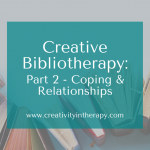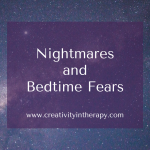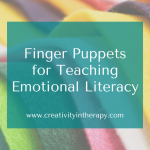
Developing a growth mindset and learning to move forward from mistakes is such an important thing for kids to learn. If you work with children and teens, you’ve probably heard statements like this before “I’m just not good at____.” “Everyone is better than me.” “I can’t do it.” “I messed it up and it’s too hard. I give up.” In art therapy, we often see clients struggle with worry that they aren’t good enough at art, get stuck or overwhelmed in their art (and life) due to perfectionism, high-expectations, or self-doubt, and experience frustration when they feel that they have made a mistake in their art.
I love the books below for the messages that they hold about having a growth mindset, accepting that we all make mistakes, continuing to try at something, and letting go of perfectionism while embracing creativity, playfulness, and self-acceptance. (Some have been grouped together because they are similar and the connected art prompts overlap so much.)
Have a young client who feels like they aren’t good at art, can’t be creative, or don’t know where to start with their art process? The Dot tells the story of a child who thinks that they can’t make art, but learns that we all have the ability to be creative.
Activities/Prompts – Create your own painting that starts with a dot (or many dots). See how many different types of dot art you can make. Or make a mini-journal to take home with the prompt to make some kind of mark every day. Create art with dots using q-tips, circle stickers, or dot markers. Create dot mandalas (fill a whole circle with dots and circles or create watercolor circles and fill them in later with patterns using markers/pens). If you are working with a group, it’s wonderful to see all the different responses based on a simple dot.
For additional ideas:
Round up of dot activities from The Artful Parent – https://artfulparent.com/19-dot-art-ideas-for-kids/
Dot Day post of 4 activities – http://www.jennyknappenberger.com/4-easy-dot-day-activities/
2. The Thing Lou Couldn’t Do, by Ashley Spires
& The Magical Yet, by Angela DiTerlizzi
Both of these books encourage a growth mindset by reminding kids that just because we can’t do something yet, that doesn’t mean we won’t be able to learn how.
Activities/Prompts – Draw yourself doing something that you used to be unable to do but learned to do. Draw yourself doing something that you are working on being able to do. Create your own “Yet” creature and then role play what it can tell you the next time you struggle with something.
Like The Dot, this book reminds kids that they don’t need to be perfect in order to be creative and express themselves through art. The main character is constantly frustrated that his drawings aren’t as good as he wants, but an opportunity to see them though his little sister’s eyes helps him let go of the perfectionism and enjoy making art again.
Activities/Prompts – Create your own ish drawing/painting. Try drawing the same thing several times in different ways (quickly, slowly, different styles, blind contour, etc.) Paint watercolor on wet paper, notice how it’s hard to control what happens. Draw an ish picture with a sharpie (no re-dos!) – if you mess up you can’t erase it and just need to be ok with it. Draw about and discuss something in your life that you just want to be able to do for fun and enjoy, regardless of how good you are at it.
4. Beautiful Oops, by Barney Saltzberg
The Book of Mistakes, by Corinna Luyken
The Girl Who Never Made Mistakes, by Mark Pett and Gary Rubinstein
These three books all address the idea of making mistakes and not letting ourselves get stuck on them. In Beautiful Oops and The Book of Mistakes, we see how something that seems to be a mistake can be the next step in the creative process. In The Girl Who Never Made Mistakes, the main character learns that it’s ok if she does mess up and that life can be more fun when she stops doing everything perfectly.
Activities/Prompts – Make art based on an oops by putting splats of paint, drips, scribbles, etc. on paper, then turn the page into a developed art piece. (In my SEL group I had several pieces pre-prepared with random drips of watercolor and each child chose one to use for an art piece.) Make art with a silly mistake on purpose (eg, what would a giraffe with a short neck look like? Or an upside down house?) Work on a collaborative art piece – the therapist and the client can each create an intentional mistake and then have the other person respond creatively to it. Or simply read these books in therapy with a child who has struggled with accepting mistakes in their art therapy process, then discuss how it can inform their mindset next time they make art.

Did you miss the other creative bibliotherapy posts? Be sure to take a look.
Creative Bibliotherapy Part 1: Exploring Emotions
Creative Bibliotherapy Part 2: Healthy Relationships and Coping
Creative Bibliotherapy Part 3: Be Yourself
If you’re thinking about ordering any of these books, remember that shopping through affiliate links on the post help support the blog. You can check out my book list on Bookshop.org to support both the blog and independent bookstores. Or find any of these books on Amazon.
I’d love to hear your thoughts! Did I miss a great mindset book that I should add? And if you give one of these activities a try (either with client or for your own fun art-making), I’d love to hear how it goes.
Carolyn Mehlomakulu, LMFT-S, ATR-BC is an art therapist in Austin, Texas who works with children, teens, and families. For more information about telehealth and online therapy, individual therapy, child and teen counseling, and art therapy services, please visit: www.therapywithcarolyn.com. Carolyn is also the author of The Balanced Mind – A Mental Health Journal, a guided journal that combines writing and art prompts to support your mental health.
This blog post contains affiliate links and I earn a small commission for your purchases. This blog is not intended to diagnose or treat any mental health conditions. All directives, interventions, and ideas should be used by qualified individuals within the appropriate bounds of their education, training, and scope of practice. Information presented in this blog does not replace professional training in child and family therapy, art therapy, or play therapy. Art therapy requires a trained art therapist.










Hi Carolyn,
Thanks so much. As an Art therapist and a mom, I anxiously await and sincerely appreciate your posts, resources and I LOVED the ART in DBT course. Please offer more and continue your great and impactful work.
Be safe and well in Austin!
Thank you for the kind words! And so glad to hear that you enjoyed the Art in DBT course. Be well!
FYI.. tomorrow is International Dot Day.. it’s based on The dot book.
Oh, thanks for pointing that out! And what a lovely coincidence!